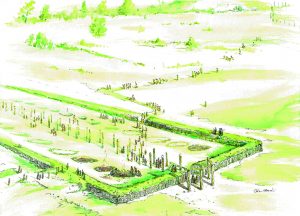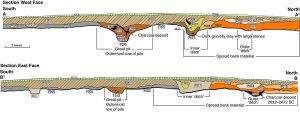County: Meath Site name: Newgrange Farm, Newgrange
Sites and Monuments Record No.: ME019-129---- Licence number: 18E0369
Author: Geraldine Stout and Matthew Stout
Site type: Cursus
Period/Dating: —
ITM: E 700661m, N 772475m
Latitude, Longitude (decimal degrees): 53.692222, -6.475928
A research excavation at Newgrange Farm, Co. Meath, which took place over four weeks between 2 and 27 July 2018, was funded by the Royal Irish Academy. The main aim of the excavation was to determine the date and function of a massive, rectilinear sub-surface feature identified by Joanna Leigh in a geophysical survey undertaken in 2015 (Leigh 2015). Although the extent of this feature was not fully revealed in the geophysical survey, its scale and location within the rich archaeological landscape of the Boyne Valley suggested a site of major significance.
The site is located in the townland of Newgrange, 216m south of Newgrange passage tomb (ME019-045) and within the core area of Brú na Bóinne World Heritage Site. It is situated on the highest fluvio-glacial terrace above the River Boyne east of Newgrange Farm and 400m north-west of the satellite passage tomb known as ‘Site A’ (ME019-049001). Although the area is best known for its passage tombs, there is also a concentration of henge monuments in the vicinity – defined by earth, pits, stone and timber. There is another cursus nearby, to the east of Newgrange passage tomb (ME019-044001) and a pit alignment has been identified extending north-west from the end of the cursus.
A 2m by 25m trench was manually excavated from the top sod to the undisturbed gravels across a representative section of the northern half of the site. The location of the trench was selected to uncover the external ditch-like features and internal pit alignments identified in the geophysical survey. In order to maximise the recovery of finds, extensive sieving of excavated soil was undertaken during the excavation. Nonetheless, finds were limited in number. A preliminary inspection of the flints by Dr Conor Brady has identified 36 flint artefacts, 3 chert artefacts and one siliceous artefact. Much of the flint is debitage and includes many platform flakes, flake fragments and chunks. Two pieces of flint are burnt and many are patinated, indicating recycling. The artefacts identified include a chert platform core, a possible bipolar core, a scraper fragment and a possible broken barbed and tanged arrowhead.
Stratified sampling of relevant contexts for post-excavation analysis and sieving on site was carried out and a total of 25 bulk soil samples were processed. No charred seeds were found but there was charcoal in most of the deposits. A radiocarbon date of a charcoal sample from the basal fill of the outermost ditch was sent to Queen's University Belfast, providing a C14 date of between 2632 BC and 2472 BC.
The discovery of the hybrid cursus monument at Newgrange farm and its subsequent excavation has profound implications for our understanding of Late Neolithic ceremonial activities in the Bend of the Boyne. The monumentality of this ceremony has, until now, been dominated by the remarkable concentration of henge monuments. Newgrange Farm reminds us that procession was an equally important aspect of seasonal ceremonial assembly and that monumental pathways were constructed for this purpose. This hybrid cursus monument further highlights the traditions shared between Britain and Ireland in Late Neolithic ceremonial practice and monumentality. This represents a marked shift from the passage tomb-building communities whose strongest links were with the coastal fringes of continental Europe. The limited excavation accomplished its two-fold purpose: to establish the existence of features identified in the geophysical survey and to get some indication of the date of this unique monument. Further excavations are required if we are to better understand the ceremony, material culture and economy of the builders of this Late Neolithic hybrid cursus monument.
A full report of this excavation can be found at Joanna Leigh, Geraldine Stout and Matthew Stout, 'Report on the research excavation at Newgrange Farm 2018' in Ríocht Na Midhe, 30, pp 15–51. This excavation is also featured in Joanna Leigh, Geraldine Stout and Matthew Stout, ‘A pathway to the cosmos at Newgrange Farm’, Archaeology Ireland, 32:4 (Winter, 2018), pp 25–9.
[caption id="attachment_48779" align="alignnone" width="300"] Reconstruction of Newgrange Cursus (painting by Colm O'Brien).[/caption]
Reconstruction of Newgrange Cursus (painting by Colm O'Brien).[/caption]
[caption id="attachment_48780" align="alignnone" width="72"] Plan of the excavations at Newgrange Farm.[/caption]
Plan of the excavations at Newgrange Farm.[/caption]
[caption id="attachment_48781" align="alignnone" width="300"] Sections, Newgrange Farm cursus.[/caption]
Sections, Newgrange Farm cursus.[/caption]
[caption id="attachment_48782" align="alignnone" width="300"] Geophysical survey of Newgrange Farm cursus by Joann Leigh.[/caption]
Geophysical survey of Newgrange Farm cursus by Joann Leigh.[/caption]
[caption id="attachment_48783" align="alignnone" width="300"] Aerial view of Newgrange Farm excavations.[/caption]
Aerial view of Newgrange Farm excavations.[/caption]
Chapel Road, Julianstown